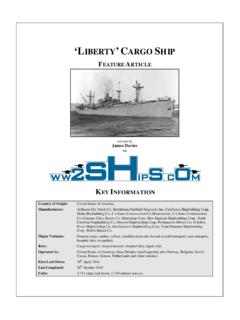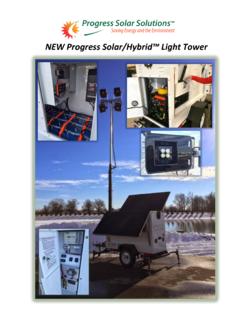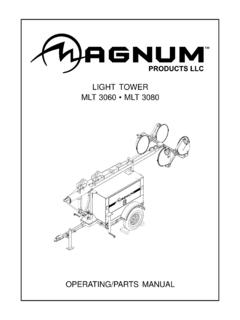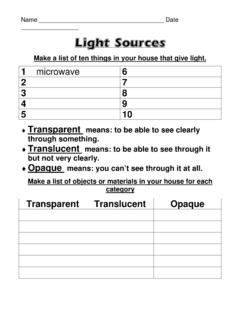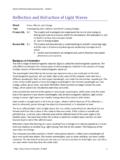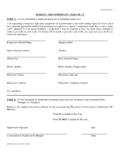Transcription of TOWN CLASS LIGHT CRUISER - World War Two Ships
1 town CLASS LIGHT CRUISER FEATURE ARTICLE written by James Davies For KEY INFORMATION Country of Origin: Great Britain. Manufacturers: Devonport Dockyard (Plymouth), Scotts (Greenock), Vickers-Armstrong (Tyne), John Brown (Clyde) Major Variants: Southampton CLASS , Liverpool CLASS , Edinburgh CLASS Role: Reconnaissance, commerce protection, convoy escort Operated by: Royal Navy First Laid Down: October 1934 Last Completed: November 1937 Units: HMS Southampton, HMS Newcastle, HMS Sheffield, HMS Glasgow and HMS Birmingham Released by WW2 Ships James Davies FEATURE ARTICLE BRITISH CRUISERS town CLASS LIGHT CRUISER Contents May 2004 2 of 12 CONTENTS town CLASS LIGHT Key Operational Specifications (As-Built).
2 7 Major Modifications Up To Modifications Appendix A: Surviving Appendix B: Production Released by WW2 Ships James Davies FEATURE ARTICLE BRITISH CRUISERS town CLASS LIGHT CRUISER Introduction May 2004 3 of 12 INTRODUCTION Cruisers were formally defined in the 1930 London Treaty as Surface vessels of war, other than capital Ships or aircraft carriers, the standard displacement of which exceeds 1,850 tons (1,880 metric tons), or with a gun above inch (130 mm) calibre . These were further sub-divided in to two sub classes: heavy cruisers, which carried guns between inches (155 mm) and eight inches (203 mm), and LIGHT cruisers with guns of six inches (152 mm) or below.
3 The Southampton CLASS CRUISER is a LIGHT CRUISER . The original variants of the town CLASS cruisers were the Southampton CLASS Ships . Five Southampton CLASS cruisers were built by Great Britain (HMS Southampton, HMS Newcastle, HMS Sheffield, HMS Glasgow and HMS Birmingham), entering service just prior to the start of the Second World War. All apart from HMS Southampton survived the war, although all of the Ships were damaged in action. The design was updated for the Liverpool CLASS (HMS Manchester, HMS Gloucester and HMS Liverpool), then again for the Edinburgh CLASS (HMS Belfast and HMS Edinburgh).
4 Three of these five Ships were lost. Despite being designated as LIGHT cruisers, the advantage of firepower between the heavy and LIGHT cruisers did not always lie in Ships with the bigger guns. In particular, the heavier eight inch gun took longer to reload, and because of this the six inch guns could put a heavier weight of shell out per minute than the eight inch guns. This was offset by the increased range of the eight inch guns. This meant that with good visibility the advantage clearly went to the heavy CRUISER , with its ability to severely damage a LIGHT CRUISER before it could get in range to use its guns. However in conditions of poor visibility, or at night, the increased range was of no benefit, and the LIGHT CRUISER was at an advantage as its faster-firing weapons could inflict more damage in a shorter period of time.
5 Overall, the town CLASS was seen to be a success, with proven ability to stay afloat and continue to fight after sustaining considerable damage, effective main guns, adequate armour and sufficient speed - all the qualities of a good CRUISER . In common with all Ships of their time the Southampton CLASS was shown to be initially lacking in air defence, although as the war progressed significant improvements were made to the anti-aircraft guns and this deficiency was rectified. Released by WW2 Ships James Davies FEATURE ARTICLE BRITISH CRUISERS town CLASS LIGHT CRUISER Development May 2004 4 of 12 DEVELOPMENT In 1922 the Washington Treaty placed limitations on aircraft carriers and on the number of Ships over 10,000 tons displacement ( capital Ships ).
6 Ships below 10,000 tons were only limited by the size of the guns, which was fixed at a maximum of eight inches (203 millimetres). Further limitations were imposed in the 1930 London Treaty, putting a cap on the total tonnage of cruisers for the first time. In addition, the total number of heavy cruisers were limited to 15 for Britain. The Southampton CLASS CRUISER was conceived as a LIGHT CRUISER to fit within the limits set by the 1930 treaty. Under heavy criticism, twelve six inch (152 mm) guns (in four turrets) were selected as the main weapons. Pressure to increase this to 15 guns (to match the Japanese Mogami CLASS and the American Brooklyn CLASS ) was resisted, on the grounds that this would break the 10,000 ton limit set by the treaties, although given the generally liberal interpretation of ship displacement by other powers the refusal appears strange.
7 Under normal operating conditions the guns could fire eight rounds per minute each, and had a maximum range of approximately 25,500 yards (23,317 metres). Each round weighed 112 pounds ( kg), and (unlike the rounds for eight inch guns) could be manually handled in the event of power failure. Armour for the Ships was chosen to provide some protection against the eight inch shells fired by heavy cruisers (which the Southampton CLASS might be expected to fight), although they could not be expected to withstand the much heavier guns of capital Ships . Aircraft were provided for a reconnaissance role, and having experienced problems in other Ships maintaining aircraft in an air-worthy condition the Ships were fitted with two aircraft hangars - the first British cruisers to be so equipped.
8 The aircraft were launched by catapult from the ship, and were recovered by crane after landing on the water. The chosen aircraft was the Supermarine Walrus, which was a single engine amphibious biplane. It had a crew of four and a maximum speed of 135 miles per hour (217 kilometres per hour). It was armed with one inch ( mm) machinegun in the front (in an open position in front of the cockpit), one or two inch ( mm) machineguns in the aft dorsal position (again in an open position), and could carry 600 pounds (272 kg) of bombs or depth charges. Eight four inch (102 mm) guns were chosen for dual purpose air defence and short range weaponry, and had a rate of fire of 20 rounds per minute.
9 These were supplemented with two four barrelled pom-poms, which were a cut down version of the eight barrelled weapon fitted to larger Ships . These guns fired 115 rounds per minute per barrel, and were effective out to 1,100 metres (1,203 yards). Finally, eight inch (13 mm) machineguns were installed in two mounts of four guns each, although these were found to be prone to jamming. The pre-war lack of appreciation of the threat posed by aircraft can be seen in this LIGHT selection of anti-aircraft weaponry. Torpedo tubes were provided in case the vessel had to go in to action against a capital ship, which could be expected to withstand six inch (152 mm) guns.
10 During the war changes were continually made to the vessels to meet the needs of the areas where they were operating in at the time, to keep up to date with technological developments and to reflect war experience. By early 1941 no two Ships mounted the same equipment, and by the end of 1941 there were no unmodified Southampton CLASS cruisers. The development of each ship through the war is shown in the table at the end of this document. [Note: only significant modifications have been shown]. The threat posed by aircraft can be clearly seen by the rapid increase in anti aircraft armament. The installation of radar made the aircraft obsolete, and their removal considerably reduced the potential for fire when under attack.
